Gastropod looks at food through the lens of science and history.
Co-hosts Cynthia Graber and Nicola Twilley serve up a brand new episode every two weeks.
Co-hosts Cynthia Graber and Nicola Twilley serve up a brand new episode every two weeks.
The story of seaweed will take us from a medicine hut in southern Chile to a high-tech seaweed nursery in Stamford, Connecticut, and from biofuels to beer, as we discover the surprising history and bright future of marine vegetables. Along the way, we uncover the role kelp can play in supporting U.S. fishermen, cleaning up coastal waters, and even helping make salmon farms more sustainable.
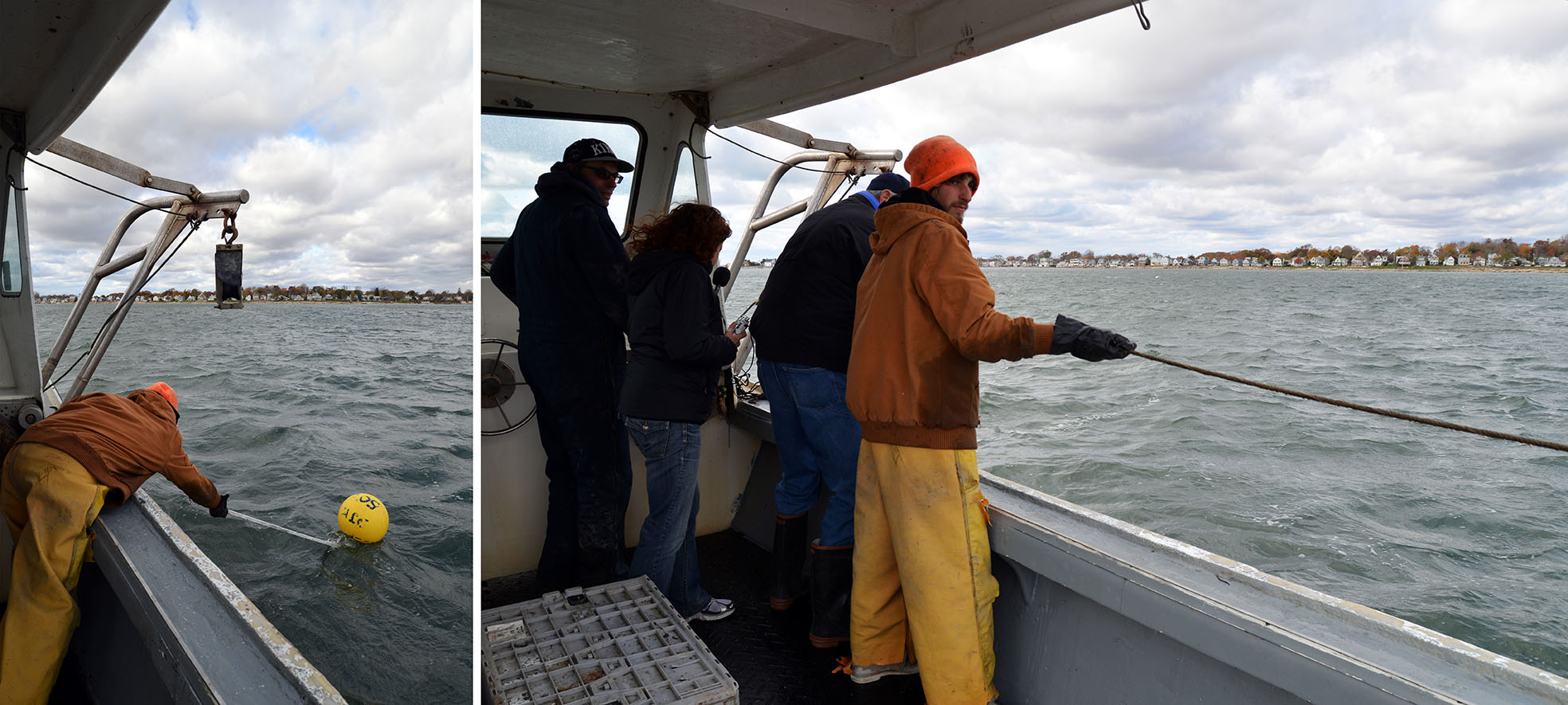 D. J. King's crew haul up the kelp line, attached to a buoy. Photo by Nicola Twilley.
D. J. King's crew haul up the kelp line, attached to a buoy. Photo by Nicola Twilley.
As a wild food, foraged from the rock cliffs and littoral strand of the world's coastlines, seaweed has been an important food, fuel, and fertilizer since ancient times. In Japan, seaweed was such an crucial part of the diet that legislation in AD 703 confirmed the right of the Japanese to pay their taxes to the Emperor in kelp form. According to Scottish kelp scientist Iona Campbell, traces of it have been found in Orkney island cremation sites dating back to the Bronze Age. Even further back in history, archaeozoologist Ingrid Mainland has confirmed that the use of seaweed as a fodder for sheep in the Orkneys, which still continues today, dates to the Neolithic period, roughly 5,000 years ago.
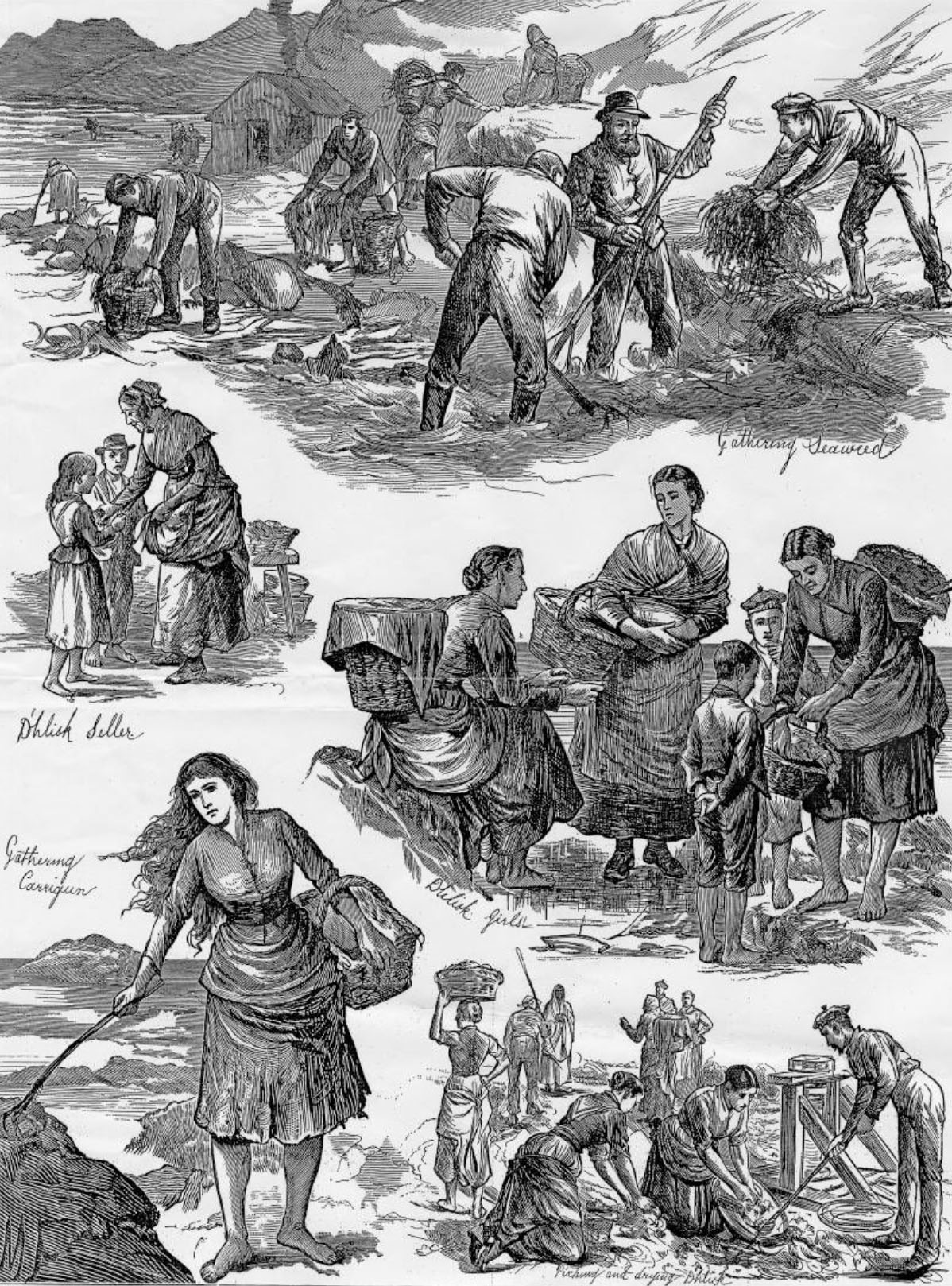 "Irish Distress: gathering seaweed for food on the coast of Clare," from the Illustrated London News, May 12, 1883.
"Irish Distress: gathering seaweed for food on the coast of Clare," from the Illustrated London News, May 12, 1883.
Surprisingly, scientists have found even older seaweed remains in the Americas, from 12,500 years ago. Five chewed cuds of Gigartina, a red seaweed, mixed with Boldo leaves, a medicinal herb and mild hallucinogen, were found on the floor of a medicine hut at Monte Verde, Chile—one of the oldest human habitation sites in the Americas. In the episode, Jack Rossen, the archaeobotanist who excavated the site's fragile plant remains using dental picks, explained how the site's age and location, combined with the four different species of seaweed found in the medicine hut and in residential areas, led to the development of an entirely new theory to explain how humans arrived in North America.
Rossen also pointed out that the Monte Verde findings led to a re-evaluation of the importance of plants in the diet of hunter-gatherers—and thus also of the role of women in those early human communities.
We've always had the stereotype of early people being hunters, big-game hunters. And now we’re thinking more that plants would have been a much more reliable resource; they just didn't get preserved as well at most sites. And maybe archaeologists, when archaeology was dominated by men, just liked the idea of being big tough hunters, instead of wimpy plant gatherers.
As it turns out, women have also played a pivotal role in transforming kelp from wild to farmed food. Basic seaweed cultivation techniques began to be developed in Japan beginning in the mid-seventeenth century. But, despite becoming a staple food of the Japanese, the basic biology of edible seaweed species remained almost completely unknown until two centuries later, when pioneering British scientist Kathleen Drew-Baker saved the country's nori farming industry.
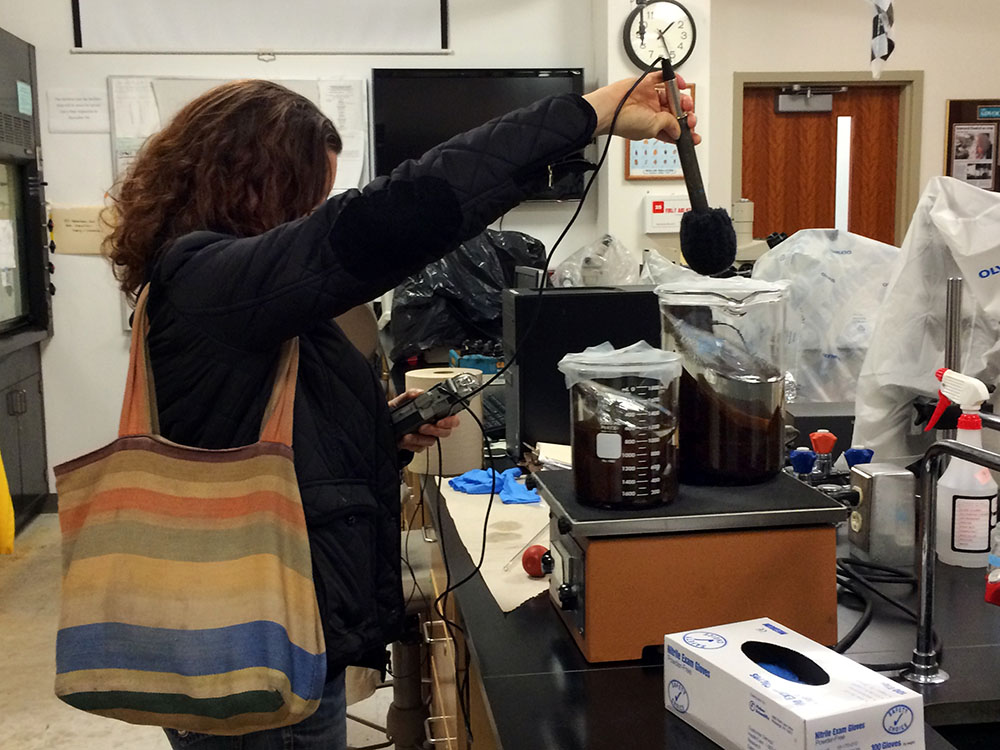 Cynthia recording the sound of seaweed sex in Charles Yarish's lab. Photo by Nicola Twilley.
Cynthia recording the sound of seaweed sex in Charles Yarish's lab. Photo by Nicola Twilley.
In 1948, a series of typhoons combined with increased pollution in coastal waters had led to a complete collapse in Japanese nori production. And because almost nothing was known about its life cycle, no one could figure out how to grow new plants from scratch to repopulate the depleted seaweed beds. The country's nori industry ground to a halt, and many farmers lost their livelihoods.
Meanwhile, back in Manchester, Dr. Drew-Baker was studying laver, the Welsh equivalent to nori. In 1949, she published a paper in Nature outlining her discovery that a tiny algae known as Conchocelis was actually a baby nori or laver, rather than an entirely separate species, as had previously been thought. After reading her research, Japanese scientists quickly developed methods to artificially seed these tiny spores onto strings, and they rebuilt the entire nori industry along the lines under which it still operates today. Although she's almost unknown in the U.K., Dr. Drew-Baker is known as the "Mother of the Sea" in Japan, and a special "Drew" festival is still held in her honor in Osaka every April 14.
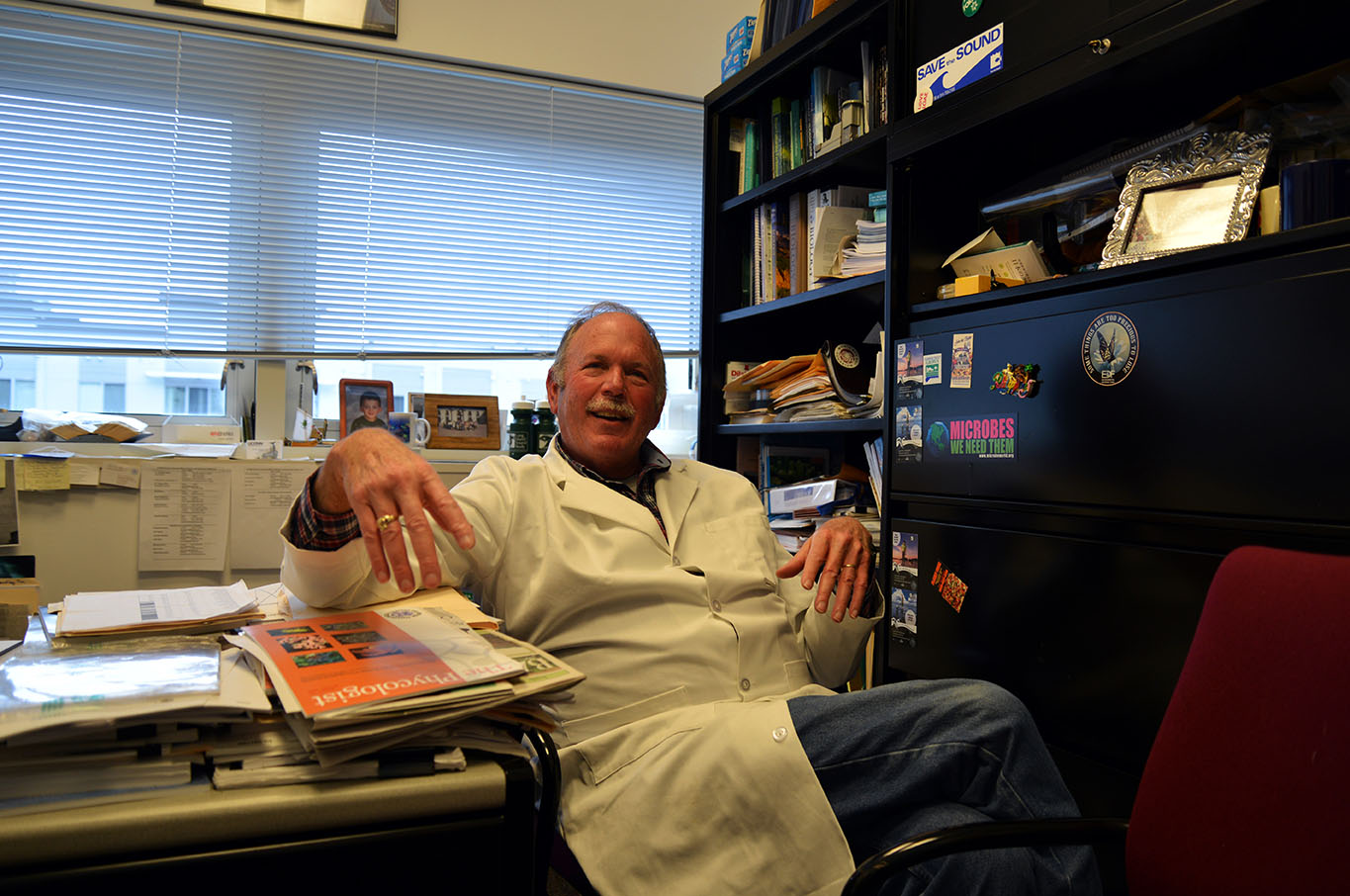 Charles Yarish in his office. Photo by Nicola Twilley.
Charles Yarish in his office. Photo by Nicola Twilley.
In the United States, Charles Yarish should probably be called the "Father of the Sea." The University of Connecticut marine biologist has spent the past forty years studying the biology of seaweeds, and then applying his research to develop revolutionary new techniques for growing seaweed off the coast of North America. His innovations have helped make make kelp an economically viable crop for the fishermen and shellfish farmers of New England, whose livelihoods have been threatened by a combination of over-fishing, pollution, and warming waters.
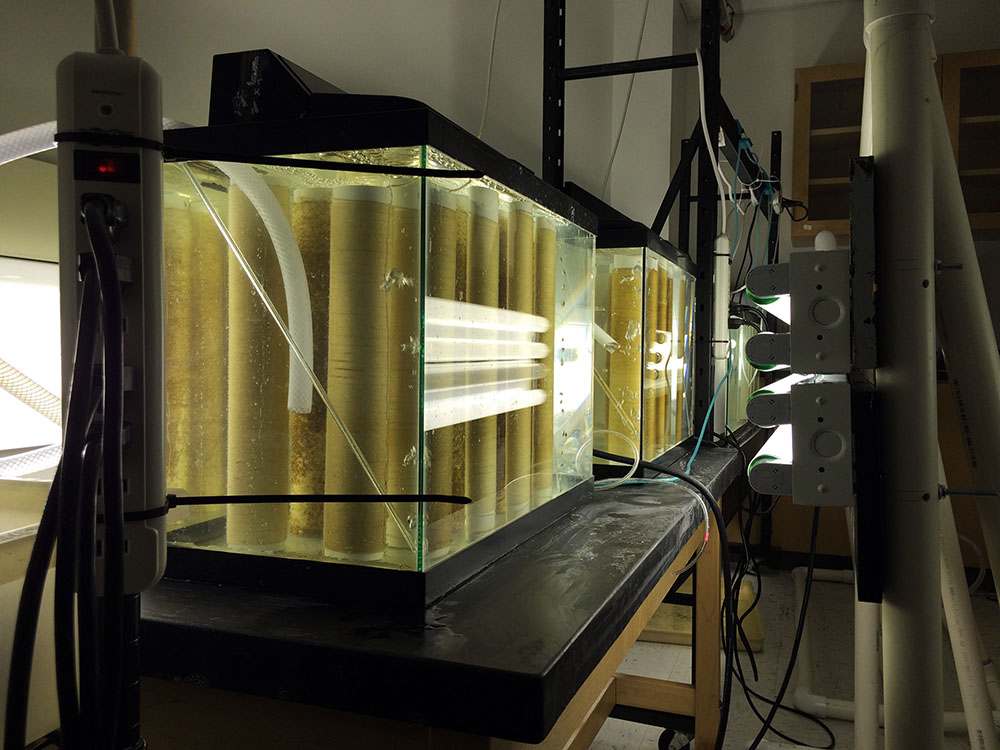 Spools seeded with baby kelp, growing in Charles Yarish's lab. Photo by Nicola Twilley.
Spools seeded with baby kelp, growing in Charles Yarish's lab. Photo by Nicola Twilley.
Listen to this episode of Gastropod for a visit to Yarish's lab to learn what he accomplished, and how seaweed farms can help soak up pollution from aquaculture, such as salmon farming, as well as from agricultural run-off and sewage. You'll also hear how seaweed is something of a superfood; research in China has even demonstrated that it contains compounds that lower cholesterol and blood glucose levels in mice. Now the only remaining challenge is to convince Americans to eat it: Gastropod visits chef Elaine Cwynar's kitchen at Johnson & Wales University to sample creative new recipes.
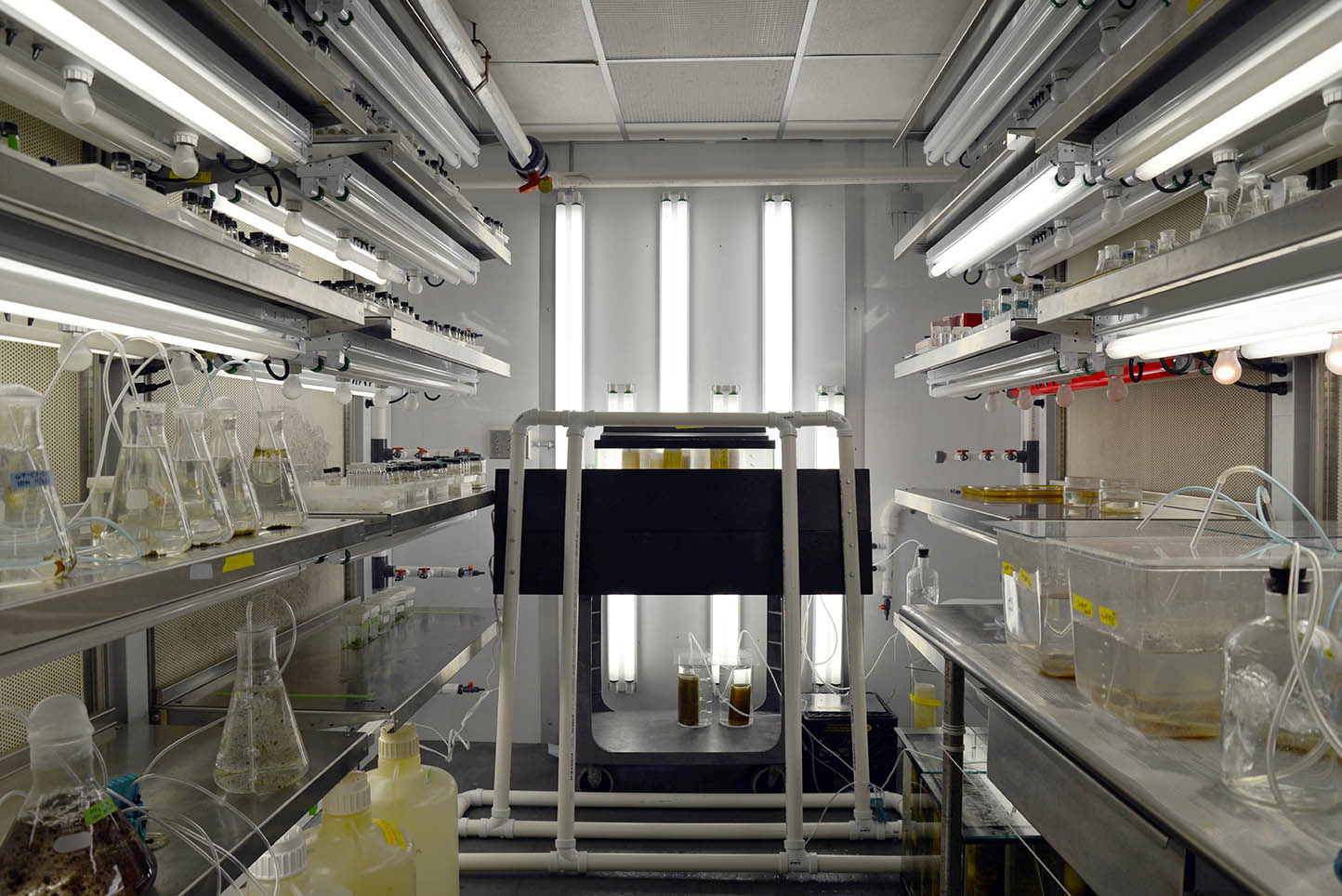 Charles Yarish's seaweed nursery. Photo by Nicola Twilley.
Charles Yarish's seaweed nursery. Photo by Nicola Twilley.
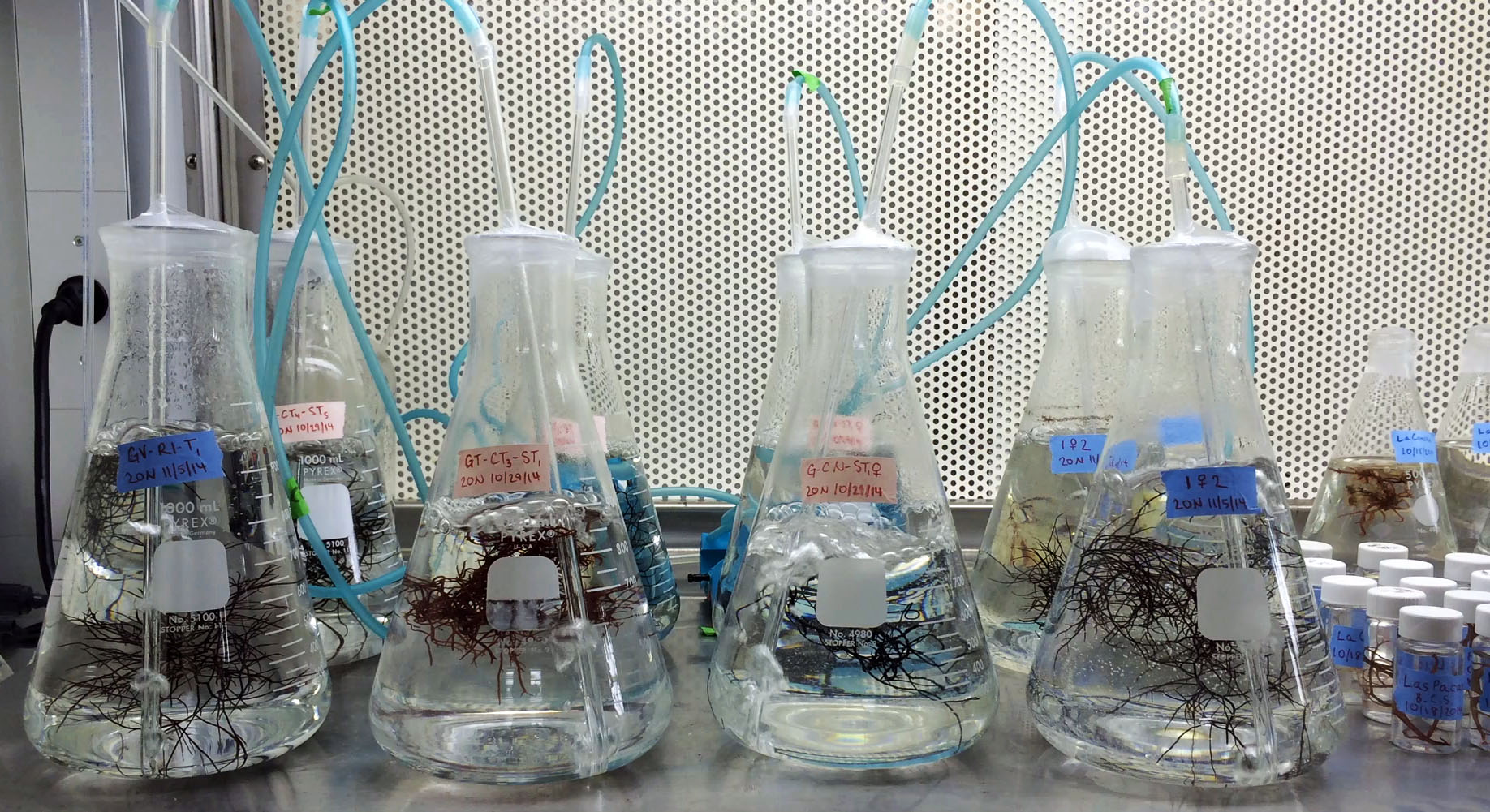 Charles Yarish's seaweed nursery. Photo by Nicola Twilley.
Charles Yarish's seaweed nursery. Photo by Nicola Twilley.
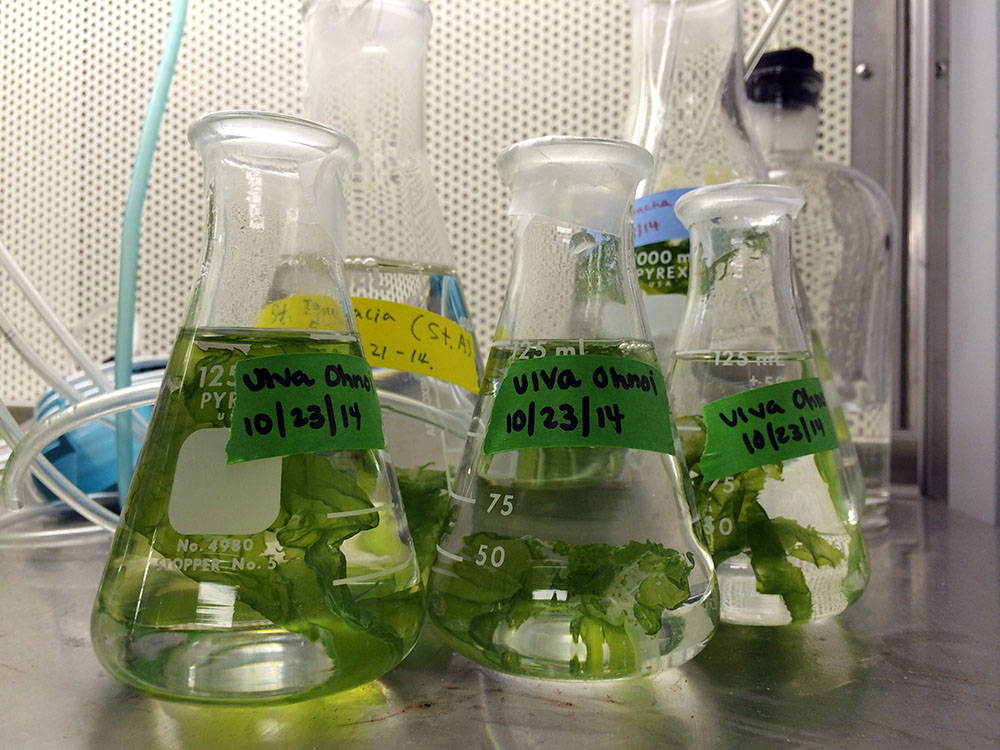 Charles Yarish's seaweed nursery. Photo by Nicola Twilley.
Charles Yarish's seaweed nursery. Photo by Nicola Twilley.
Before we get to kelp, a note about our recent episode on subnatural cuisine. After listener Natasha Godard heard it, she recommended we check out Mikki Kendall’s article on food gentrification at The Grio. It’s a powerful piece about poverty and food appropriation, and we’re glad Mikki could join us on the show.
Our New England seaweed adventures were made possible thanks to the loan of Cynthia's partner Tim Buntel's car: thanks for your wheels and your ears, Tim!
Scottish kelp scientist Iona Campbell maintains a blog describing her research into the large-scale cultivation of kelp as a biofuel, as well as various other seaweed-related topics, including a recent "seaweed exchange" visit to China.
Archaeozoologist Ingrid Mainland discovered the telltale signs of seaweed-eating on Neolithic-era sheep skulls in the Orkneys. Her findings were published in a 2009 paper titled "Stable isotope evidence for seasonal consumption of marine seaweed by modern and archaeological sheep in the Orkney archipelago." The contemporary seaweed-eating sheep she used as a comparison are the unique North Ronaldsay breed.
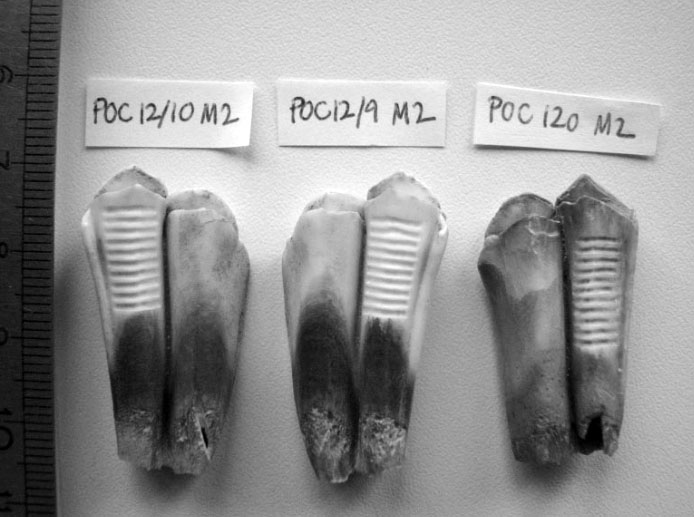 Tooth-enamel sampling on Neolithic sheep molars. Photo from Ingrid Mainland's paper.
Tooth-enamel sampling on Neolithic sheep molars. Photo from Ingrid Mainland's paper.
Archaeologist Jack Rossen helped excavate the Monte Verde site and, as a result, became completely obsessed with seaweed. With Tom Dillehay and others, he co-authored a 2008 paper on the significance of the seaweed findings at the site: "Monte Verde: Seaweed, Food, Medicine, and the Peopling of South America."
Dr. Kathleen Drew-Baker is most likely the only seaweed scientist to have a statue erected in her honor. You can read more about her work here and here, as well as in this PDF.
As we mention in the episode, Charles Yarish and his colleagues literally wrote the book on seaweed biology in 1990: a 600-page tome titled Seaweeds: Their Environment, Biogeography and Ecophysiology. Everything you ever wanted to know about seaweed—and more!
Charles Yarish applied his research into seaweed biology and physiology into developing techniques for kelp farming along the United States' Atlantic Coast. He helped set up and continues to work with nine seaweed farms, including DJ King’s in the Thimble Islands (the farm we visit in the episode) and Tollef Olson and Paul Dobbins' farm, Ocean Approved, in Maine.
Another farmer who’s received a lot of attention for his multi-species "3D ocean farms" is Bren Smith of Thimble Island Oysters, who also relied on Charlie’s help to create his floating ropes and cages that combine seaweed, mussels, oysters, and clams.
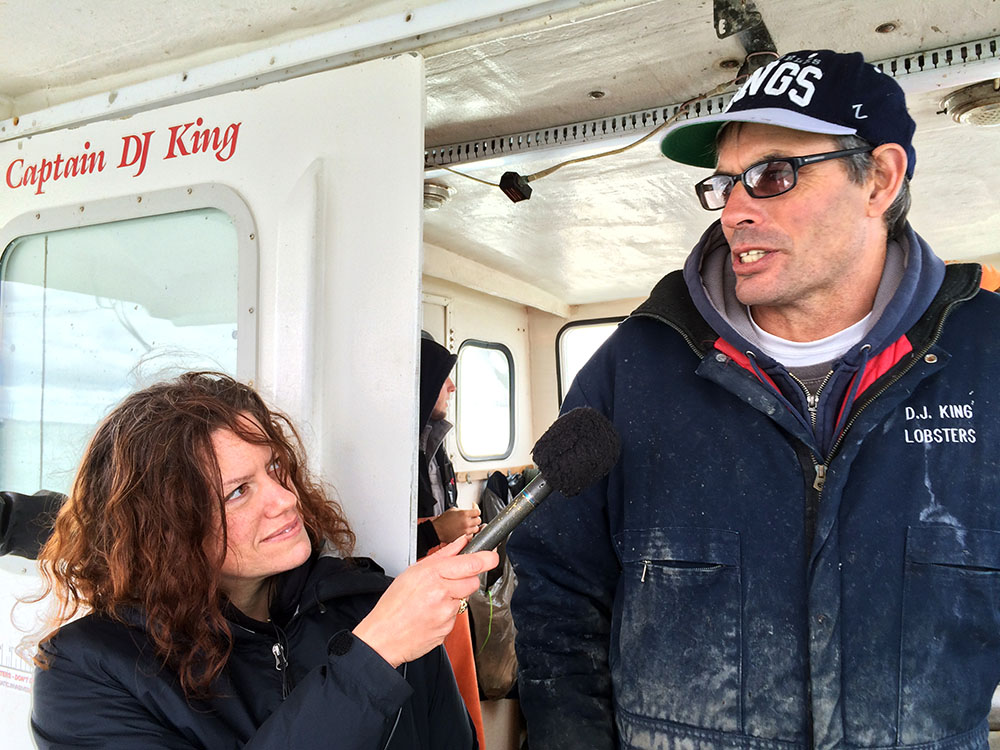 Kelp farmer D. J. King talking to Gastropod co-host Cynthia Graber aboard his boat. Photo by Nicola Twilley.
Kelp farmer D. J. King talking to Gastropod co-host Cynthia Graber aboard his boat. Photo by Nicola Twilley.
Bren Smith works with several popular restaurants in New York, and Tollef Olson’s Ocean Approved sells kelp to chefs, universities, and other institutions. As Tollef admits, there’s still work ahead to develop the market for fresh/frozen seaweed. The only retail stores that carry his products at this time are in his hometown of Portland, Maine. But don’t despair: Tollef does sell kelp online! It’s only available in bulk, however, in amounts ranging from 2 to 3 pounds.
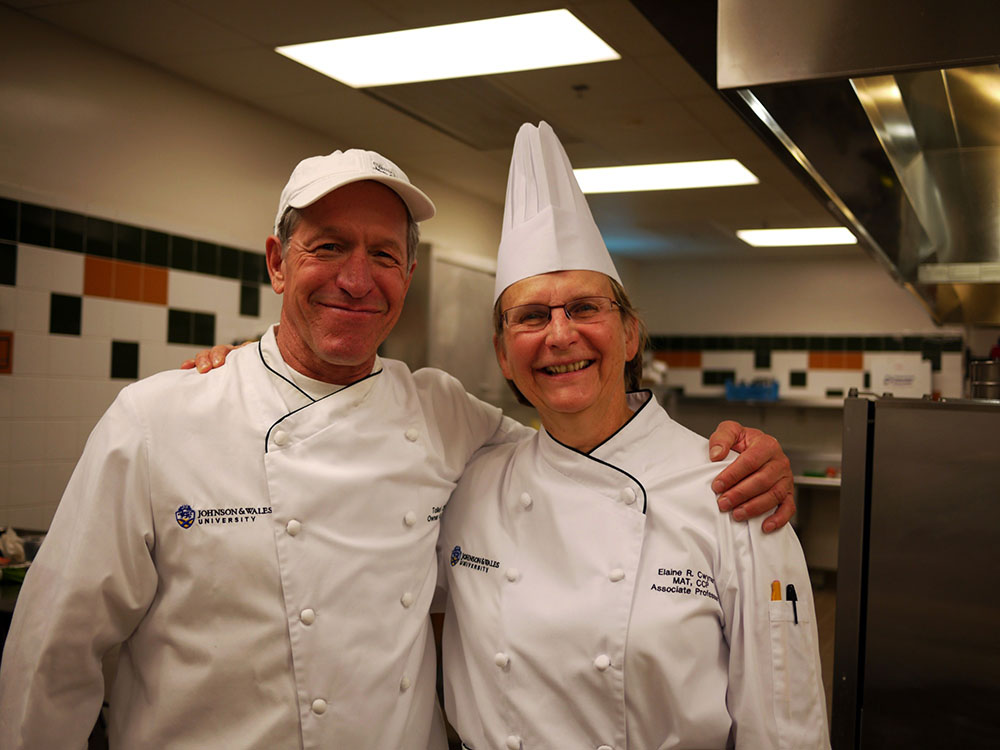 Tollef Olson and Elaine Cwynar at Johnson & Wales. Photo by Cynthia Graber.
Tollef Olson and Elaine Cwynar at Johnson & Wales. Photo by Cynthia Graber.
If you do ever get your hands on some of this seaweed, you’ll want to figure out what to do with it. (Other than eat it plain, of course. Cynthia insists that it probably wouldn’t last long enough in her apartment to make it into any recipe.) Chef Elaine Cwynar of Johnson & Wales hasn’t published her recipes online, but she and her students have worked closely with Tollef, and he has a variety of recipes on the Ocean Approved website.
You’ll find instructions on how to make everything from smoothies pumped up with pureed seaweed to veggie and kelp meatballs. And, of course, you’ll find the recipe for the carrot-kelp cake that Cynthia loved and her partner Tim's colleagues refused to try. Cynthia recommends blending a bit of the puree into the frosting just for the gorgeous, green-flecked effect.